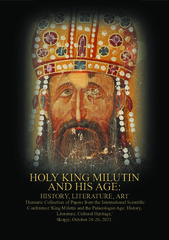Prikaz osnovnih podataka o dokumentu
Краљица Јелена у улози супруге
Queen Helen in the role of a wife
| dc.contributor | Ћировић, Јасмина С | |
| dc.contributor | Убипаровић, Србољуб | |
| dc.creator | Митровић, Катарина С. | |
| dc.date.accessioned | 2023-11-11T00:36:54Z | |
| dc.date.available | 2023-11-11T00:36:54Z | |
| dc.date.issued | 2023 | |
| dc.identifier.uri | http://reff.f.bg.ac.rs/handle/123456789/5224 | |
| dc.description.abstract | Задатак овог рада је да осветли приватни и породични живот краљице Јелене (око 1250–1314), посебно њене односе са супругом краљем Урошем (1243–1276). Изворну подлогу чине њихова житија из пера архиепископа Данила Другог, Јеленино писмо–заклетва упућено дубровачком архиепископу, кнезу и општини, као и чињеница да је краљица ктиторка манастира Градац. Подаци из житија противрече писму–заклетви, док околности у којима је Градац подигнут бацају ново светло на односе у краљевској породици. Тумачењу изворних вести приступили смо и из угла дубинске психологије и трансакционе анализе као теорије о развоју понашања. Резултат представља условна реконструкција Јелениног лика у улози супруге. | sr |
| dc.description.abstract | This paper considers private and family life of Queen Helen (about 1250– 1314) and particularly her relationship with her husband, King Uroš I (1234– 1276). The main source of information were the King and Queen’s biographies written by Archbishop Danilo II. These biographies were composed long after deaths of the main characters, based on the author’s memories and the tales of their peers, with the aim of depicting interactions within the royal family in the most favourable light. The relationship of Helen and Uroš was described as an ideal Christian marriage in which the wife followed the will of her husband in everything. However, in more than one place in the biographies, Danilo had described Helena’s personality as independent, mature and authentic, particularly in regard to her son Dragutin who rose to the throne in 1276 by coup. One other source – Helena’s letter– oath written at the court in Brnjaci, of unestablished date, which was addressed to the Archbishop, Rector and the Commune of Ragusa, showed that the Queen was willing to secretly make decisions which were not in compliance with the official policies and positions of her husband. Helen had erected and donated to the Gradac Monastery, aiming to be buried in her foundation, together with her husband Uroš and their loyal friend Archbishop Joanikije. This also tells us much about the relationship between the spouses. The source information was approached from the depth psychology angle and using transactional analysis as a behavioural development theory. The result is a potentially plausible reconstruction of Helena’s character in terms of her role as a wife. | sr |
| dc.language.iso | sr | sr |
| dc.publisher | Издавачка кућа Епархије шумадијске ,,Каленић“ | sr |
| dc.relation | info:eu-repo/grantAgreement/MESTD/inst-2020/200163/RS// | sr |
| dc.rights | openAccess | sr |
| dc.rights.uri | https://creativecommons.org/licenses/by/4.0/ | |
| dc.source | Свети краљ Милутин и његово доба: историја, књижевност, уметност. Тематски зборник међународног научног скупа „Краљ Милутин и доба Палеолога: Историја, књижевност, културно наслеђе”, Скопље 24–26. октобар 2021. | sr |
| dc.subject | краљица Јелена | sr |
| dc.subject | краљ Урош I | sr |
| dc.subject | краљ Драгутин | sr |
| dc.subject | архиепископ Данило II | sr |
| dc.subject | Градац | sr |
| dc.subject | Дубровчани | sr |
| dc.title | Краљица Јелена у улози супруге | sr |
| dc.title | Queen Helen in the role of a wife | sr |
| dc.type | bookPart | sr |
| dc.rights.license | BY | sr |
| dc.citation.epage | 53 | |
| dc.citation.spage | 37 | |
| dc.identifier.doi | 10.46793/6008-065-5.037M | |
| dc.identifier.fulltext | http://reff.f.bg.ac.rs/bitstream/id/12791/bitstream_12791.pdf | |
| dc.type.version | publishedVersion | sr |

